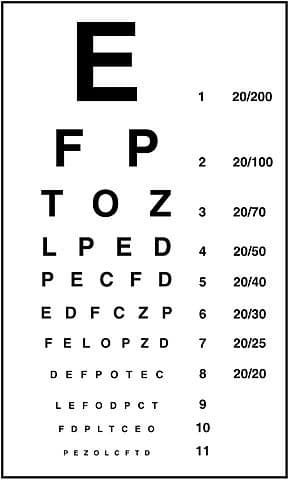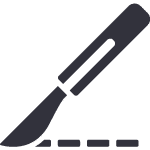Introduction
- Introduce yourself to the patient
- Wash your hands
- Briefly explain to the patient what the examination involves
It is good practice to work sequentially through the cranial nerves; be prepared to be instructed to move on quickly to certain sections by any examiner.
The Examination
Olfactory Nerve
Ask the patient if they have noticed any change in sense of smell:
- Characteristic smelling objects (e.g. peppermint) can be used to further discriminate pathologies, asking patient to close eyes and examining each nostril in turn
Optic Nerve
The optic nerve should be examined by various modalities:

Figure 1: Example of a Snellon Chart used to assess Visual Acuity
- Visual Acuity (VA) – Assess VA with a Snellen chart. Keep glasses on to correct for any refractory errors
- Stand the patient 6m away from the chart, covering each eye separately with their hand in turn
- Find the line of print which the patient can comfortably read at*
*VA is expressed as the distance between the patient and the chart over the number next to the smallest line that was read (e.g. 6/24 is an individual standing 6m away from the chart and can only read letters that a normal individual can read from 24m)
Alternatively, VA can be simply assessed by asking the patient to read text from a book or magazine
- Visual Fields
- Ask the patient to cover their left eye with their left hand and then cover your right eye with your right hand. The patient must continue to look straight ahead
- Move your hand to the patient’s upper temporal visual field quadrant
- Gradually move your finger to the centre of their vision from the periphery and ask the patient to inform you as soon as they see your finger moving
- Repeat for the lower temporal, upper nasal, and lower nasal fields, then repeat on the other eye
Any abnormality detected can be further assessed by perimetry or central field assessment
- Fundoscopy – Dim the lights if possible. Ask the patient not to look directly at the light (allowing the eye to stay in a fixed position)
Oculomotor, Trochlear, and Abducens Nerves
Assessment of cranial nerves III, IV, and VI:
- Pupillary light reflex
- Ask the patient to fixate on a distant target
- Shine a pen torch into each eye in turn, bringing the beam in quickly from the lateral side
- Observe both the direct (ipsilateral) and consensual (contralateral) response
- Pupillary accommodation – The accommodation reflex involves both convergence of the eyes (requiring adduction of both eyes) and simultaneous constriction of the eyes
- Ask the patient to look at an object held at distance
- Bring the object to within 10cm of the patient, asking the patient to follow it with their eyes
- Watch the pupils for equal convergence and constriction
- Ask the patient to look straight ahead and check for signs of nystagmus or ptosis
- Ocular movements
- Ask the patient to keep their head still and follow an object
- Move the object around in an H formation, assessing both horizontal and vertical gaze
- Watch the pupils to assess the eye movements and any signs of nystagmus
- Checking the conjugate gaze may also be warranted at this point
Ensure to ask the patient to let you know if they experience any double vision throughout
Trigeminal Nerve
Both sensory and motor branches of the trigeminal nerve should be tested:
- Sensation requires both light touch and pin prick assessment
- Demonstrate to the patient what to expect from the light touch and pin prick sensations
- Ask the patient to close their eyes and gently touch the forehead, cheeks, and chin regions (assessing ophthalmic, maxillary, and mandibular branches respectively)
- Ensure to ask the patient to let you know if they experience any changes in sensation either side or cannot feel the sensation
- Motor function is checked by the muscles of mastication
- Ask the patient to clench their teeth tight and palpate for the contraction in the temporalis muscle and masseter muscle
- Ask the patient to open their mouth, move their jaw from side to side, then close their mouth
Testing of the corneal reflex should not be performed unless sensory impairment suspected, as it is uncomfortable to the patient
Facial Nerve
Testing the facial nerve involves the assessment of the muscles of facial expression:
- Initially assess for symmetry in the face at rest
- Ask the patient to perform the following movements
- Raise their eyebrows
- Close their eyes tightly
- Blow out their cheeks
- Smile
These movements should also be able to be completed against the examiner’s resistance
Vestibulocochlear Nerve
Examination of cranial nerve VIII should cover both cochlear and vestibular function:
- Hearing can be assessed by whispering a number into each ear separately, making a distracting noise with your fingers in the contralateral ear, and asking the patient to repeat
- If any hearing loss suspected, perform Rinne’s and Weber’s test
- Balance has no truly satisfactory test for assessment
- Formal vestibular testing can be performed
Glossopharyngeal and Vagus Nerves
CN IX and CN X nerves can be assessed together:
- Ask the patient to cough (assessing CN X)
- Ask the patient to open the mouth wide and say ‘ah’, using a tongue depressor to visual the palate and posterior pharyngeal wall (assessing CN IX and X)
- The soft palate should move upwards centrally
Testing of the gag reflex should not be performed unless bulbar impairment is suspected, as it is uncomfortable to the patient.
Accessory Nerve
The accessory nerve is a purely motor branch to the trapezius and sternocleidomastoid muscles:
- Sternocleidomastoid can be assessed by asking the patient to turn their head to each side, against the examiners resistance
- Trapezius can be assessed by asking the patient to shrug their shoulders, against the examiners resistance
Hypoglossal Nerve
The hypoglossal nerve is a purely motor branch to the muscles of the tongue:
- Ask the patient to open their mouth and inspect the tongue for any wasting or fasciculation
- Ask the patient to protrude the tongue and move from side to side
Completing the Examination
Remember, if you have forgotten something important, you can go back and complete this.
To finish the examination, stand back from the patient and state to the examiner that to complete your examination, you would like to perform a neurological examination of the limbs
